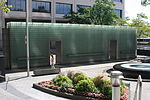Montague Street Tunnel
1920 establishments in New York CityBrooklyn–Manhattan Transit CorporationCrossings of the East RiverNew York City Subway infrastructureRailroad tunnels in New York City ... and 2 more
Tunnels completed in 1920Tunnels in Manhattan

The Montague Street Tunnel is a rail tunnel of the New York City Subway under the East River between the boroughs of Manhattan and Brooklyn, connecting the BMT Broadway Line and BMT Fourth Avenue Line. The R uses the tunnel at all times, the N uses it during late nights, and during rush hours, several W trains per day in each direction use the tunnel.
Excerpt from the Wikipedia article Montague Street Tunnel (License: CC BY-SA 3.0, Authors, Images).Montague Street Tunnel
East River Esplanade, New York Manhattan
Geographical coordinates (GPS) Address Website Nearby Places Show on map
Geographical coordinates (GPS)
| Latitude | Longitude |
|---|---|
| N 40.698055555556 ° | E -74.005555555556 ° |
Address
Downtown Manhattan Heliport (Downtown Manhattan/Wall St. Heliport)
East River Esplanade
10041 New York, Manhattan
New York, United States
Open on Google Maps








